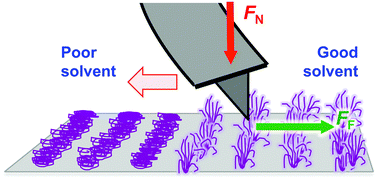Nanotribological properties of nanostructured poly(cysteine methacrylate) brushes
Abstract
The nanomechanical properties of zwitterionic poly(cysteine methacrylate) (PCysMA) brushes grown from planar surfaces by atom transfer radical polymerisation have been characterised by friction force microscopy (FFM). FFM provides quantitative insights into polymer structure–property relationships and in particular illuminates the dependence of brush swelling on chain packing in nanostructured materials. In ethanol, which is a poor solvent for PCysMA, a linear friction–load relationship is observed, indicating that energy dissipation occurs primarily through ploughing. In contrast, in a good solvent for PCysMA such as water, a non-linear friction–load relationship is observed that can be fitted by Derjaguin–Muller–Toporov (DMT) mechanics, suggesting that the relatively small modulus of the swollen polymer leads to a large contact area and consequently a significant shear contribution to energy dissipation. The brush grafting density was varied by using UV photolysis of C–Br bonds at 244 nm to dehalogenate the surface in a controlled fashion. The surface shear strength increases initially as the brush grafting density is reduced, but then decreases for UV doses greater than 0.5 J cm−2, reaching a limiting value when the brush thickness is ca. 50% that of a brush monolayer. Below this critical grafting density, a collapsed brush layer is obtained. For nm-scale gradient brush structures formed via interferometric lithography, the mean width increases as the period is increased, and the lateral mobility of brushes in these regions is reduced, leading to an increase in brush height as the grafted chains become progressively more extended. For a width of 260 nm, the mean brush height in water and ethanol is close to the thickness of a dense unpatterned brush monolayer synthesised under identical conditions. Both the surface shear stress measured for PCysMA brushes under water and the coefficient of friction measured in ethanol are closely correlated to the feature height, and hence to the chain conformation.



 Please wait while we load your content...
Please wait while we load your content...